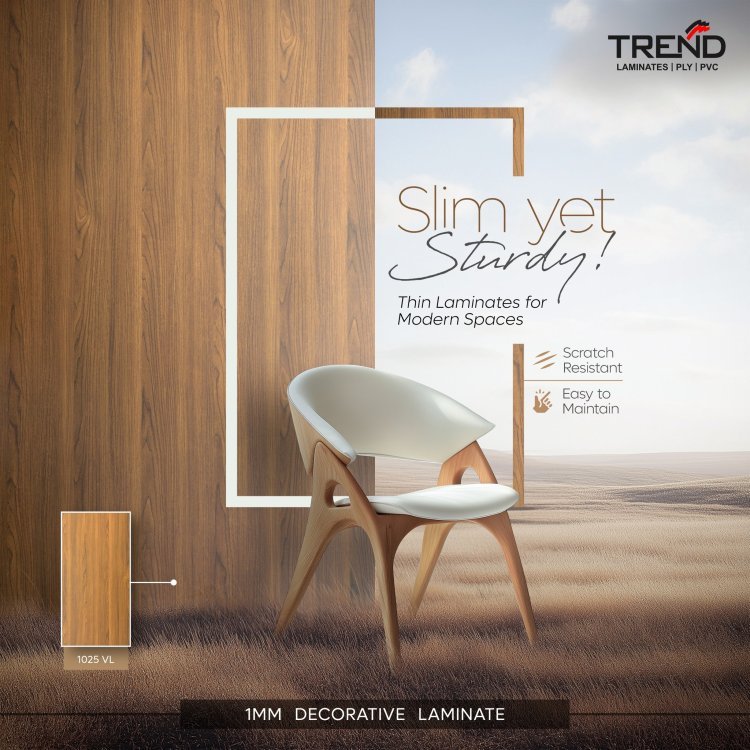What Are The Major Differences Between 0.8mm & 1mm Decorative Laminate Sheets?
0.8mm laminate sheets and 1mm laminate sheets offer unique advantages, making them suitable for different applications.

Decorative laminate sheets are an essential element in modern interior design, offering both aesthetic appeal and functional durability. Among the various options available, 0.8mm laminate sheets and 1mm laminate sheets are popular choices for residential and commercial projects. While they may seem similar at first glance, these two variants differ in several critical aspects that influence their suitability for different applications. This blog will explore the key differences between 0.8mm and 1mm laminate sheets to help you make an informed decision for your interior design needs.
1. Thickness and Durability
The primary difference between 0.8mm and 1mm laminate sheets is their thickness. As the names suggest:
- 0.8mm laminate sheets have a thickness of 0.8 millimeters.
- 1mm laminate sheets have a thickness of 1 millimeter.
Impact on Durability
- 0.8mm laminates are thinner and therefore slightly less durable than their 1mm counterparts. They are ideal for applications where heavy wear and tear are not a concern, such as vertical surfaces like wall panels or cabinet shutters.
- 1mm laminates are thicker and more robust, making them better suited for horizontal surfaces like countertops, tabletops, and work desks, where they are subjected to frequent use and potential impact.
2. Cost Effectiveness
Cost is another significant factor that differentiates these two types of laminate sheets:
- 0.8mm laminate sheets are generally more affordable, making them a budget-friendly choice for projects with large surface areas, such as office partitions or home furniture.
- 1mm laminate sheets are slightly more expensive due to their increased thickness and durability. However, their long-term performance often justifies the higher initial investment.
3. Applications
Both 0.8mm and 1mm laminate sheets have unique applications based on their characteristics:
0.8mm Laminate Sheet Applications:
- Vertical Surfaces: Ideal for cabinet shutters, wall panels, and wardrobe doors where minimal stress is applied.
- Low-Traffic Areas: Suitable for decorative purposes in spaces with less foot traffic or minimal handling.
- Budget Projects: Perfect for large-scale projects with tight budgets.
1mm Laminate Sheet Applications:
- Horizontal Surfaces: Best suited for countertops, desks, and shelves that endure frequent use and abrasion.
- High-Traffic Areas: Ideal for commercial spaces like restaurants, offices, and retail stores where durability is crucial.
- Heavy-Duty Use: Recommended for furniture pieces requiring added strength and resistance to impact.
4. Flexibility and Ease of Installation
When it comes to flexibility, 0.8mm laminate sheets are slightly more pliable than 1mm sheets due to their reduced thickness. This makes them easier to handle and install, especially on curved or irregular surfaces. However, the added rigidity of 1mm laminates provides better stability once installed, making them a preferred choice for flat and robust applications.
5. Aesthetic Appeal
Both 0.8mm and 1mm laminate sheets come in a wide variety of designs, colors, and textures. However, the choice between the two often depends on the visual impact you wish to create:
- 0.8mm laminate sheets are lightweight and ideal for creating sleek and minimalist designs.
- 1mm laminate sheets offer a more substantial appearance, making them suitable for creating bold and pronounced design elements.
6. Scratch and Impact Resistance
The thickness of laminate sheets directly influences their resistance to scratches and impacts:
- 0.8mm laminates offer decent scratch resistance but are less capable of withstanding heavy impacts.
- 1mm laminates provide superior resistance to both scratches and impacts, making them a more reliable choice for high-traffic areas or spaces prone to accidental damage.
7. Moisture and Heat Resistance
Both 0.8mm and 1mm laminate sheets are designed to withstand a certain level of moisture and heat exposure. However, the thicker 1mm laminates offer better protection in high-moisture or high-heat environments, such as kitchens and bathrooms. If longevity in such conditions is a priority, opting for 1mm laminates is the better choice.
8. Weight
The difference in thickness also affects the weight of these laminate sheets:
- 0.8mm laminate sheets are lighter, making them easier to transport and install on vertical surfaces.
- 1mm laminate sheets are heavier, which enhances their stability and performance on horizontal surfaces but requires more effort during installation.
9. Maintenance Requirements
Both types of laminates are relatively low-maintenance, but their durability impacts the frequency of upkeep:
- 0.8mm laminates may require more frequent touch-ups or replacements in high-usage areas due to their thinner profile.
- 1mm laminates are more durable and retain their appearance longer, reducing the need for maintenance.
10. Environmental Impact
If sustainability is a concern, consider the following:
- 0.8mm laminates use less raw material, making them a slightly more eco-friendly option.
- 1mm laminates, while using more material, often last longer, reducing waste over time. Choosing between the two depends on your specific environmental priorities.
How to Choose Between 0.8mm and 1mm Laminate Sheets?
When deciding between 0.8mm laminate sheets and 1mm laminate sheets, consider the following factors:
- Application: Determine whether the surface will be subjected to heavy use or light handling.
- Budget: Evaluate the cost-effectiveness based on your project requirements.
- Durability Needs: Assess the level of wear and tear the laminate will face.
- Design Goals: Choose a thickness that complements your desired aesthetic.
Conclusion
Both 0.8mm laminate sheets and 1mm laminate sheets offer unique advantages, making them suitable for different applications. While 0.8mm laminates are a cost-effective solution for vertical surfaces and low-traffic areas, 1mm laminates provide superior durability and are ideal for horizontal surfaces and high-traffic spaces. By understanding the key differences outlined in this blog, you can select the right laminate sheet to enhance the functionality and visual appeal of your interior spaces. Whether you prioritize budget, durability, or design, both options ensure a stylish and practical solution for modern interiors.
What's Your Reaction?
















